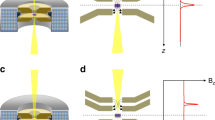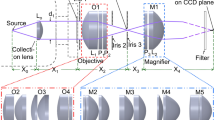Abstract
Following the invention of electron optics during the 1930s, lens aberrations have limited the achievable spatial resolution to about 50 times the wavelength of the imaging electrons1. This situation is similar to that faced by Leeuwenhoek in the seventeenth century, whose work to improve the quality of glass lenses led directly to his discovery of the ubiquitous “animalcules” in canal water, the first hints of the cellular basis of life. The electron optical aberration problem was well understood from the start, but more than 60 years elapsed before a practical correction scheme for electron microscopy was demonstrated2, and even then the remaining chromatic aberrations still limited the resolution. We report here the implementation of a computer-controlled aberration correction system in a scanning transmission electron microscope3, which is less sensitive to chromatic aberration. Using this approach, we achieve an electron probe smaller than 1 Å. This performance, about 20 times the electron wavelength at 120 keV energy, allows dynamic imaging of single atoms, clusters of a few atoms, and single atomic layer ‘rafts’ of atoms coexisting with Au islands on a carbon substrate. This technique should also allow atomic column imaging of semiconductors, for detection of single dopant atoms, using an electron beam with energy below the damage threshold for silicon.
This is a preview of subscription content, access via your institution
Access options
Subscribe to this journal
Receive 51 print issues and online access
$199.00 per year
only $3.90 per issue
Buy this article
- Purchase on Springer Link
- Instant access to full article PDF
Prices may be subject to local taxes which are calculated during checkout




Similar content being viewed by others
References
Scherzer, O. The theoretical resolution limit of the electron microscope. J. Appl. Phys. 20, 20–29 (1949)
Haider, M., Uhlemann, S., Schwan, E., Kabius, B. & Urban, K. Electron microscopy image enhanced. Nature 392, 768–769 (1998)
Crewe, A. V., Isaacson, M. & Johnson, D. A simple scanning electron microscope. Rev. Sci. Instrum. 40, 241–246 (1969)
Voyles, P. M., Muller, D. A., Grazul, J. L., Citrin, P. H. & Gossmann, H.-J. L. Atomic-scale imaging of individual dopant atoms and clusters in highly n-doped bulk Si. Nature 416, 826–829 (2002)
Crewe, A. V., Wall, J. & Langmore, J. Visibility of a single atom. Science 168, 1338–1340 (1970)
Pennycook, S. J. & Boatner, L. A. Chemically sensitive structure-imaging with a scanning transmission electron microscope. Nature 336, 565–567 (1988)
Xu, P., Kirkland, E. J., Silcox, J. & Keyse, R. High resolution imaging of silicon (111) using a 100 KeV STEM. Ultramicroscopy 32, 93–102 (1990)
Crewe, A. V., Isaacson, M. & Johnson, D. A high resolution electron spectrometer for use in transmission scanning microscopy. Rev. Sci. Instrum. 42, 411–420 (1971)
Batson, P. E. Simultaneous STEM imaging and electron-energy-loss-spectroscopy with atomic-column sensitivity. Nature 366, 727–728 (1993)
Muller, D. A., Tzou, Y., Raj, R. & Silcox, J. High resolution EELS at grain boundaries. Nature 366, 725–727 (1993)
Browning, N. D., Chisholm, M. F. & Pennycook, S. J. Atomic resolution analysis using a scanning transmission electron microscope. Nature 366, 143–146 (1993)
Dellby, N., Krivanek, O. L., Nellist, P. D., Batson, P. E. & Lupini, A. R. Progress in aberration-corrected scanning transmission electron microscopy. J. Electron. Microsc. 50, 177–185 (2001)
Batson, P. E. Structural and electronic characterization of a dissociated 60° dislocation in GeSi. Phys. Rev. B 61, 16633–16641 (2000)
Ronchi, V. Forty years of history of a grating interferometer. Appl. Opt. 3, 437–450 (1964)
Zhang, Z. Y. & Lagally, M. G. Atomistic processes in the early stages of thin film growth. Science 276, 377–383 (1997)
Kirkland, E. J. Advanced Computing in Electron Microscopy (Plenum, New York, 1998)
Kawasaki, T. et al. Development of a 1 MV field emission transmission electron microscope. J. Electron. Microsc. 49, 711–718 (2000)
O'Keeffe, M. A. et al. Sub-ångstrom high resolution transmission electron microscopy at 300 keV. Ultramicroscopy 89, 215–241 (2001)
Zuo, J., Kim, Y., O'Keeffe, M. & Spence, J. C. H. Direct observation of d holes and Cu-Cu bonding in Cu2O. Nature 401, 49–56 (1999)
Batson, P. E. Symmetry selected electron energy loss scattering in diamond. Phys. Rev. Lett. 70, 1822–1825 (1993)
Acknowledgements
O.L.K. and N.D. acknowledge partial support for this project from the IBM Corporation.
Author information
Authors and Affiliations
Corresponding author
Ethics declarations
Competing interests
The authors declare that they have no competing financial interests.
Rights and permissions
About this article
Cite this article
Batson, P., Dellby, N. & Krivanek, O. Sub-ångstrom resolution using aberration corrected electron optics. Nature 418, 617–620 (2002). https://doi.org/10.1038/nature00972
Received:
Accepted:
Issue Date:
DOI: https://doi.org/10.1038/nature00972
This article is cited by
-
Electron counting detectors in scanning transmission electron microscopy via hardware signal processing
Nature Communications (2023)
-
μeV electron spectromicroscopy using free-space light
Nature Communications (2023)
-
AtomAI framework for deep learning analysis of image and spectroscopy data in electron and scanning probe microscopy
Nature Machine Intelligence (2022)
-
Reconfigurable electronic circuits for magnetic fields controlled by structured light
Nature Photonics (2021)
-
Deep Bayesian local crystallography
npj Computational Materials (2021)
Comments
By submitting a comment you agree to abide by our Terms and Community Guidelines. If you find something abusive or that does not comply with our terms or guidelines please flag it as inappropriate.



